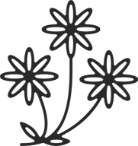
-
Why we like this plant
Cirsium rivulare 'Atropurpureum' is an excellent choice for adding vertical interest to borders, with its bold flowers providing colour and nectar for pollinators throughout the summer.
-
About this plant
Cirsium rivulare 'Atropurpureum' is a highly decorative, clump-forming perennial that brings structure and colour to borders. Unlike its wild relatives, this thistle is well-behaved, non-invasive, and produces stunning deep crimson flower heads from late spring to early autumn. The blooms are held on tall, sturdy stems above a base of deeply lobed green foliage, making it a superb choice for pollinator-friendly gardens. It thrives in moist, well-drained soil and pairs beautifully with grasses and other perennials in naturalistic planting schemes.
-
Key features
- Deep crimson, thistle-like flowers
- Long flowering period from late spring to early autumn
- Attracts bees, butterflies, and other pollinators
- Tall, upright growth perfect for mixed borders
-

Height and
spread -

Growth
habitClump-forming, upright
-

Moisture
Moderate moisture needs
-

Position in
the GardenBorders, wildlife gardens, prairie planting
Planting guide
- Plant in moist but well-drained soil
- Space plants 60cm apart for good air circulation
- Thrives in full sun but tolerates light shade
Care tips
- Deadhead regularly to encourage repeat flowering
- Cut back to ground level in late autumn
- Divide clumps every few years to maintain vigour
Winter care
- Leave seed heads for winter interest and wildlife
- Apply mulch around the base to protect roots in cold areas
- Remove any dead foliage in early spring










